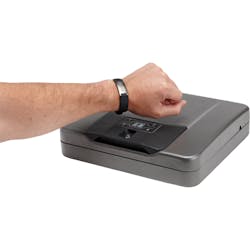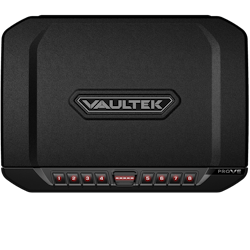Weapon Storage Continues To Go High-Tech
The number of General Orders (GOs) and Special Operations Procedures (SOPs) that have been written to give guidance on storing your duty weapon while you’re off-duty and how to transport and store your off-duty or secondary weapons is massive. Every agency in the country probably has guidance on such storage and as the technology for firearms storage continues to evolve, the GOs and SOPs probably grow in parallel. The challenge for each officer is simply to keep up with the evolving tech to ensure compliance with all of the written directives. As important as it is, that’s the wrong focus to have. The challenge we need to focus on is making sure our weapons are stored safely while still empowering sufficiently quick access if we need them in an emergency. Thankfully, the technologies being developed support exactly this need.
From old to new
Long gone are the days of taking off your gunbelt to hang it someplace in the house with your duty weapon still in the holster. Equally disappearing into the past are the days of putting your duty weapon in the nightstand drawer or up on a closet shelf. No more carrying in the shotgun and leaning it in the corner under the coat rack. No more putting it in the hall closet. With many states now mandating some type of secure storage (or mandating prosecution if your weapon isn’t stored safely), having an appropriate gun safe is becoming less of an option and more of a mandate. The typical gun safe has evolved quite a bit in recent years and we have to choose what is best for our own needs. Sure, most large safes are sufficient to store both your long guns and your handguns, but they also aren’t usually quick access. So, for most of us, we need a place we can store our long guns but a separate and quickly accessible place to store our duty handgun, off-duty handgun and/or secondary weapon (backup gun or BUG).
When it comes to safes for your home, you can get anything from room-sized vaults to single handgun lock boxes. Many of the large gun safes now incorporate fire resilience as well as options for storing electronic valuables like hard drives and CPUs. Many have USB ports and power strips incorporated into them. What’s best for you is largely dependent on how many and what type of weapons you want to store and how fast you want to be able to access them. Technology has come a long way and rapid access to your weapon(s) has improved as well.
In fact, the technology centered around gun security isn’t just about safes anymore. Liberty Safe released the SafElert Gun Safe Alarm – albeit not brand new – that you place in your safe and will alert you via SMS or email if your safe is threatened. It sends alerts for movement, burglary, fire and excessive humidity. It’s available for iOS or Android and provides you another layer of security via notification if you see the need or want that additional peace of mind.
The larger safes from companies like Liberty, Hornady, Cannon and others usually have a combination lock and key access. Some have biometrics locks as well — you have to store your finger/thumbprint and know the combination. Doing such doesn’t offer fast access though. Safes that offer faster access are largely designed to hold a handgun or two along with an extra magazine, flashlight or cell phone (or all of the above). If you’re getting a “fast access” safe for your handgun, include some other emergency items in there, too, such as a flashlight, spare magazine and cell phone or house phone. It’s a good idea to “load up” when going to investigate something suspicious.
Gun safes go high-tech
Some challenges that present themselves when we look at quick access handgun safes are:
- Can more than one user access it easily?
- Can it be picked up, taken away and broken into at a criminal’s leisure?
- Will it hold everything you need it to hold?
One example of a quick access handgun safe is the MicroVault Biometric safe from GunVault. Handgun-sized, the safe can be opened using a programmed touch combination or by scanning a stored fingerprint. The unit can store up to 20 fingerprints so more than one family member can be “authorized” to gain entry and should you need to take it on travel as extra secure storage in a hotel room or such, it comes with a four foot security cable. That can be used to tether it to an immovable (or close to it) object. At home it can be mounted to a piece of furniture that’s too heavy or too large to get through a door easily.
Another example of an electronic handgun safe is the PROVE from Vaultek. Large enough to hold two full-size handguns, the PROVE uses a backlit eight-key keypad that allows the user to create their own PIN code varying from four to eight digits in length. How fast can you access the enclosed weapon? It depends on how fast you can accurately enter the code. Your family members may not have a memory as good as yours or might not remember the code when they’re in panic mode. In cases such as those, it’s probably best to use a shorter code. The PROVE can also be mounted to something reasonably immobile for security.
Hornady – yes, the same company that manufactures ammunition – makes an interesting line of handgun safes called RAPiD. They use RFID technology to allow the safe to open when the authorized user – identified because they’re wearing the appropriate wristband – gets close enough to unlock the safe. Up to five RFID tags can be programmed for each safe allowing permitted family members access. The only challenge presented here is making sure the family member who wants to gain access has remembered to have the RFID tag with them. If they forget or anything goes wrong, there’s a secondary entry method that uses a four to six digit security code. It can be mounted to an immobile object or as an option it comes with a security cable rated to 1,500 pounds.
A fourth option is the Gunbox 2.0. It will easily fit a full size duty handgun and uses hydraulic arms to push open the lid once it has been unlocked. To unlock the box you can use a fingerprint, a RFID tag or type in a code on a keypad. Its sister design, the SK-1 Tactical, holds your weapon in a vertical position. This difference in orientation can help to hide the fact that it’s a gun safe. The SK-1 Tactical has another major difference—it’s large enough to hold a long gun as well as a couple handguns. It’s a one-stop-shop solution to holding your duty weapons and backup gun (provided you have only one long gun).
Beyond having a gun safe, there’s the ability to monitor your gun safe and other items in your house, too, by installing an indoor security camera. The Nest Cam provides 24/7 live-streaming, person alerts with Nest Aware and one app for all Nest products. It will alert you if it senses something or someone in your home and it’ll send a phone alert or an email with an image from the event. You can also define certain areas of interest, known as Activity Zones, in your camera’s view and get notified when there’s motion there, which means you will know if someone is in/around your gun safe. You’ll also have video, which could be priceless in the case of an event.Safes for multiple weapons
For officers who need to store their duty weapon when off-duty, or their off-duty with their duty weapon when they’re home, a gun safe that will safely and securely hold both is needed. Of course, storing long guns with the same kind of quick access isn’t as easy. That recognized, safe storage is mandatory and reasonably easy access for removal to go to work is equally important. The speed of access, however, isn’t as important. After all, if you’re rushing to get to work it’s usually a simple matter of setting your alarm clock a little earlier.
The larger concern is to make sure you have a safe that will hold all your duty weapons, especially in a world where the average patrol officer can have a duty handgun, backup handgun, patrol rifle, shotgun, less lethal launcher and other things we can’t even anticipate. Many officers also see the need to lock up their electronic control devices or electro-muscular disruption devices. If that’s your goal but you still need to have access to at least one handgun while you’re home (for intended defensive purposes), then a stackable safe might be your best solution. This would consist of a more traditional base safe that would hold long guns and a more technologically evolved handgun safe that bolts on top.
This combination solution allows for a central location to store your long guns in a more traditional manner while still putting your duty weapon and/or your off-duty/backup weapon in the quicker access handgun box bolted on top. The placement of such a safe would be the concern. It would have to be someplace in your home you could get to quickly to go investigate anything suspicious you heard.
One thing is for sure in today’s litigious world—you had better ensure that your weapons are secure. It doesn’t matter that you’re in your own home. There have been cases where the state’s attorney tried to prosecute a law enforcement professional for a criminal’s use of a stolen gun when the gun had been stolen from an officer. The allegation is that failing to properly secure it amounts to negligence and puts some responsibility in your lap. Whether you buy into that or not, not a single officer in the world wants to call his captain, chief or sheriff and have to tell them that he’s lost control of his duty weapon(s), even if they were stolen. It’s a headache none of us needs or wants…so lock up your guns. There are plenty of advanced options to do so and more being developed daily. So check them out and invest wisely. Know your need, learn the products available and get your weapons secured properly.

Lt. Frank Borelli (ret), Editorial Director | Editorial Director
Lt. Frank Borelli is the Editorial Director for the Officer Media Group. Frank brings 20+ years of writing and editing experience in addition to 40 years of law enforcement operations, administration and training experience to the team.
Frank has had numerous books published which are available on Amazon.com, BarnesAndNoble.com, and other major retail outlets.
If you have any comments or questions, you can contact him via email at [email protected].





